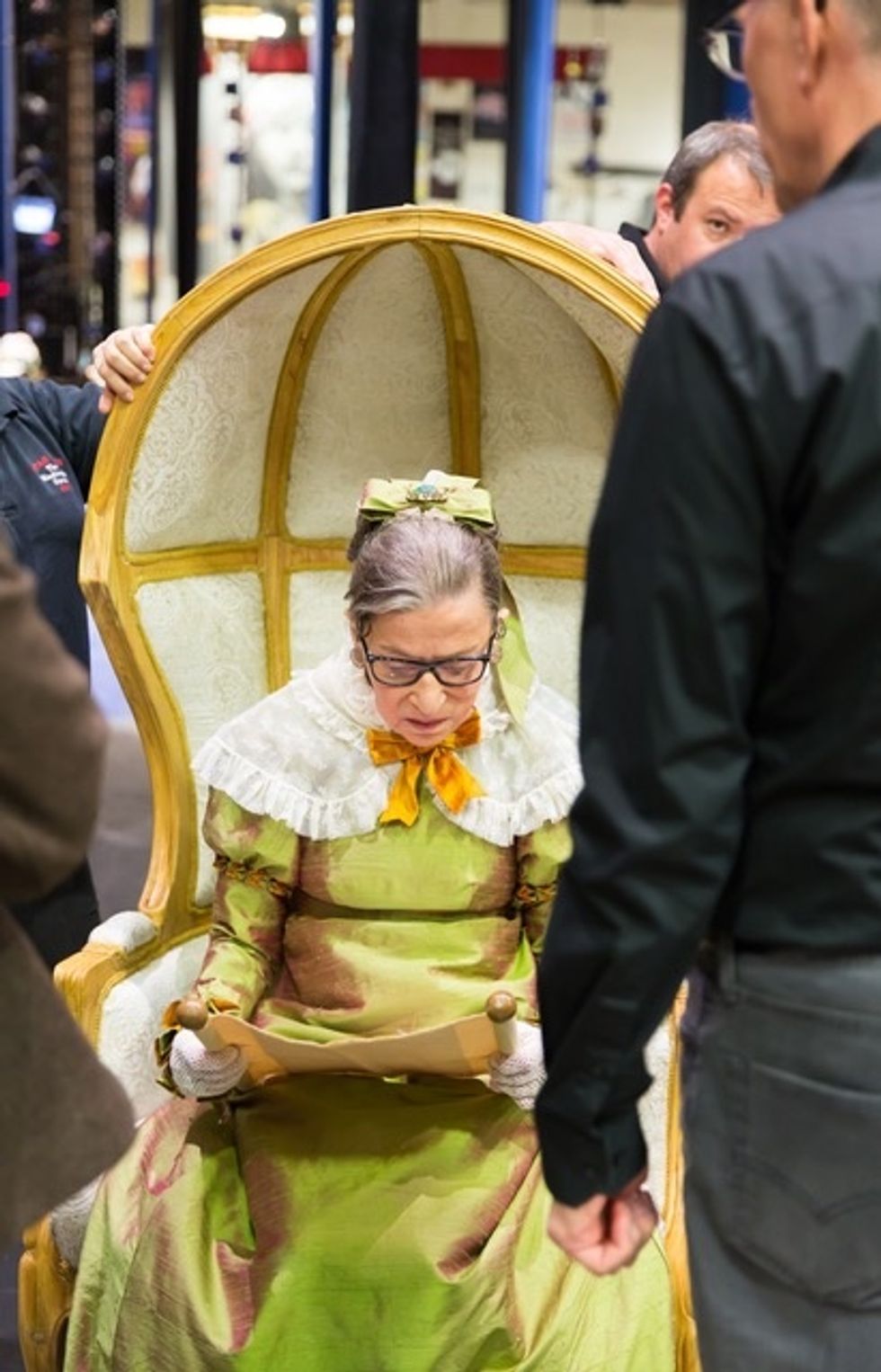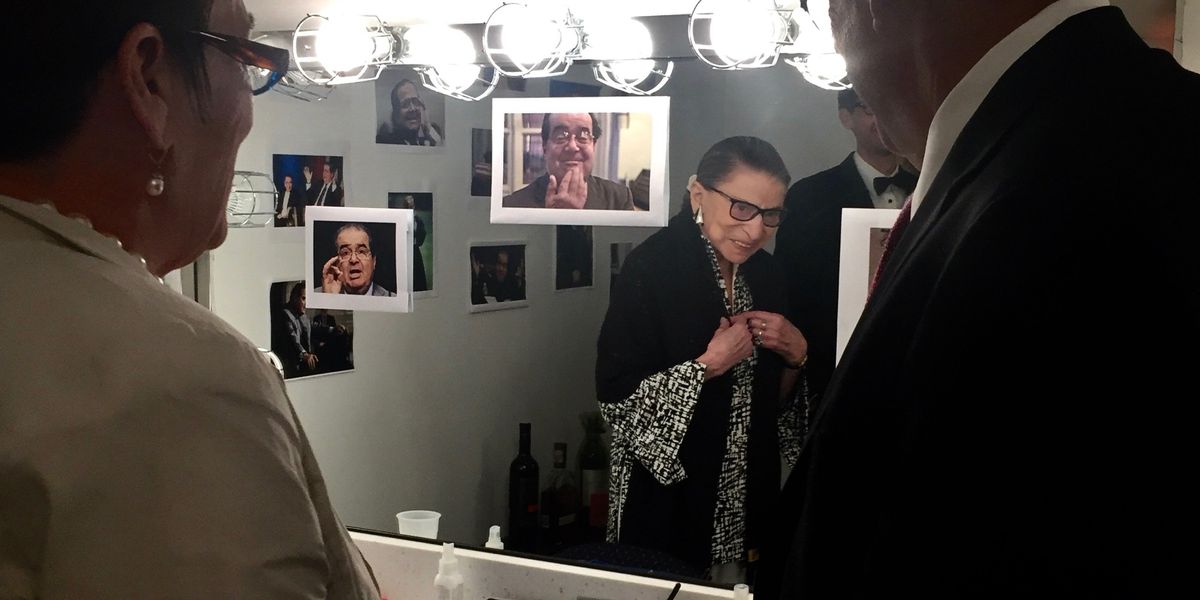What It Was Like When Ruth Bader Ginsburg Was in the Audience—or Backstage
The 27 years that Ruth Bader Ginsburg spent on the U.S. Supreme Court were 27 years that she spent as one of Washington, DC’s most ardent, elegant and erudite supporters of the performing arts. The justice, who died on September 18 of metastatic cancer, was also an avid cultural tourist, traveling to the Santa Fe and Glimmerglass operas nearly every summer, as well as occasionally returning to catch shows in her native New York City.
Ginsburg’s opera fandom was well known, but her tastes were wide-ranging. Particularly in the last 10 years of her life, after Ginsburg lost her beloved husband, Marty, it was not unusual for the petite justice and her security detail to be spotted at theaters several nights a week. She saw everything, from classic musicals to serious new plays, plus performances that defied classification, like Martha Clarke’s dance drama Chéri, with Alessandra Ferri and Herman Cornejo, which toured to the Kennedy Center in 2014.
To honor Ginsburg, Dance Magazine asked three dance artists whose performances the justice attended to recall what Ginsburg meant to them.
Natascia Diaz

Natascia Diaz (in purple) first met Ruth Bader Ginsburg when the justice came backstage after a performance of West Side Story.
Courtesy Signature Theatre
Ginsburg attended her first musical at Arlington, Virginia’s Signature Theater in 2003, and remained a subscriber until last year. Musical theater performer Natascia Diaz met the justice in 2015, when Ginsburg ventured backstage after a performance of West Side Story. Everyone knew she was coming because cast members had been warned to watch out for her security detail in the wings—nothing like bumping into the Secret Service while running from Officer Krupke!
Backstage, everyone was awestruck. “We were all so nervous,” recalls Diaz, who was performing the part of Anita. “It was like the angel Gabriel had walked in. What do you say?”
When no one else was brave enough to speak up, Diaz did, awkwardly asking, “Hello, your honor, your excellency, how do you like the show?”
“It’s wonderful and beautiful,” Ginsburg said.
The daughter of a Puerto Rican opera singer, Diaz has spent half her career playing Anita, a journey that began when she auditioned for Jerome Robbins in the mid-1990s. And yet her critically hailed performance at Signature stands out in her memory because Ginsburg came to see it.
“Ruth Bader Ginsburg was such a fan of DC theater,” Diaz says. “The fact that she made time in her brain, in her soul and in her life to actually go, and receive it—I mean, that’s just such an incredible example.”
In fall 2018, Ginsburg greeted Diaz at Signature after a performance of the Stephen Sondheim musical Passion, and paid the actress what she says may be the greatest compliment of her career: “It is amazing to me,” the justice told her, “that both Anita and Fosca came from the same person.”
“I died. I absolutely died,” Diaz says.
Ginsburg would return to see Passion two more times, a detail Diaz only learned last week when the theater pulled the justice’s ticketing records.
In recent days, Diaz has not only replayed these scenes with Ginsburg in her head, but also thought about “just what she meant to the world, and where we all need to go at this point,” she says. “We need to be energized by the passing of her torch instead of defeated by it.”
Robert Longbottom

Scott Suchman, Courtesy Longbottom
Tony-nominated director and choreographer Robert Longbottom has directed dozens of Rockettes and world-renowned sopranos, but the most memorable moments of his career may stem from directing Ginsburg herself.
After the Washington National Opera asked him to direct a new production of Donizetti’s Daughter of the Regiment in 2016, he and artistic director Francesca Zambello debated who should play the Duchess of Krakenthorp, a non-singing role usually given, Longbottom explains, to “an aging opera diva, a comedian or a drag queen.”
“How about a Washington insider?” he asked.
“How about Ruth Bader Ginsburg?” Zambello responded. Both were thrilled when the justice, a devoted supporter of the WNO, said yes.
A costume designer had a number of conversations with Ginsburg and designed a gorgeous green silk shantung gown. “I don’t think she put up any diva behavior,” Longbottom says, laughing. “I was very pleased.”
The justice’s big moment came just after intermission. Longbottom positioned Ginsburg in “the biggest chair I could find,” with its back to the audience. Act II opens with the heroine, Marie, flailing her way through a ballet class, which Longbottom choreographed. (“It’s not going well. She’s aggressively klutzy, and she runs off.”) Then the chair swung around, revealing the diminutive justice. From a scroll, she read off the details of a prospective marriage contract. Ginsburg had asked if she could tweak the wording, and ended her edict by demanding that prospective suitors show their birth certificates. It was like she dropped a bomb, Longbottom recalls, and the crowd of Washington insiders went wild. “It came off beautifully.”
To prepare for the big night, Longbottom had visited Ginsburg at her chambers just once. That rehearsal happened to be the morning after Donald Trump was elected president.
“It was one of the most memorable moments of my whole career,” Longbottom says. “A very gloomy morning, although it was a sunny day. It was such an out-of-body experience, and yet a great honor at the same time.”
The justice was not inclined to discuss the election results, he recalls; she only said, “Brexit should have clued us all in,” and then went about rehearsing for the opera.
“It was very special to have had this connection with her,” Longbottom says. Her death last week came as “a terrible shock,” he says, “and yet, she did enough. God, she had so much to bear.”
Parker Esse

Ruth Bader Ginsburg, here with Benj Pasek, Justin Paul and Steven Levenson, attended the opening of Dear Evan Hansen at Arena Stage in 2015.
Courtesy Arena Stage
Ginsburg saw choreographer Parker Esse’s shows at Arena Stage, the Kennedy Center and Signature Theatre. They met in person in 2014, when Ginsburg officiated the wedding of Suzanne Blue Star Boy and Molly Smith, Arena Stage’s longtime artistic director. That’s when Esse learned that Ginsburg had been a fan of his work since 2010, when he choreographed a groundbreaking production of Oklahoma! that cast Black women as Laurie and Aunt Eller. (Ginsburg applauded the cast’s diversity.) For the next 10 years, Ginsburg rarely missed a holiday musical at Arena Stage, culminating with her trip to see Newsies last November, a production that featured tap dance prodigy Luke Spring.
At 5′ 1′, Ginsburg reminded Esse of his mentor Baayork Lee (the original Connie in A Chorus Line). Yet, despite her small frame, Esse describes the justice as “one of the strongest women and most brilliant leaders I’ve ever met.”
“RBG was a pioneer in her role as a Supreme Court justice,” he says. “She had great respect for the performing arts, and the vital role it plays in bringing together the community, to continually challenge people in opening their hearts and minds to new ideas and experiences.”
For Ginsburg, going to the theater provided an escape while also posing questions to her ever-curious mind.
Esse says: “She was always there. It was a chance for her to put her homework aside and all the burdens of making a very difficult decision with the Supreme Court. She could escape and fall into the beautiful melody of the music, or the questions that a play would ask. These are things an audience needs. She was just like the rest of us. She needed it too.”
Although the thrill of knowing the justice came to see his shows never got old, Esse says the best responses came from young performers. “Can you imagine working your first professional job after college, and Ruth Bader Ginsburg is there to see you perform?” he says. And she wasn’t just an audience member: She was the stage-door type who relished going backstage and “congratulating everyone.”
More than anything else, Esse will miss reading postshow reports for creative team members and seeing the words “RBG is in the house” or, better yet, “RBG in the house AGAIN,” because she came to see a show twice. “That would make my heart so happy,” he says.
Now, Esse feels performing artists have a special responsibility to honor Ginsburg’s pioneering drive for equality. “Her loss is immeasurable for all those she fought to protect,” Esse says. “It is now our job to continue her work and to fiercely protect her legacy.”




